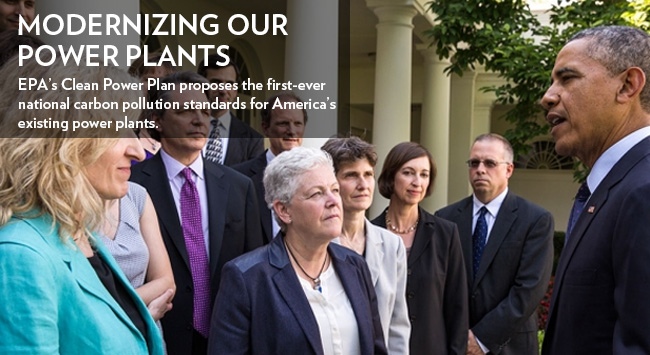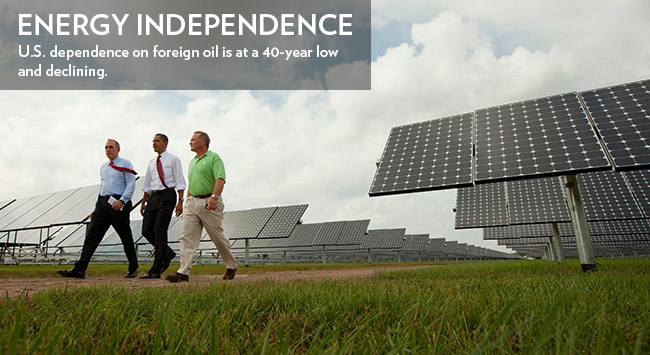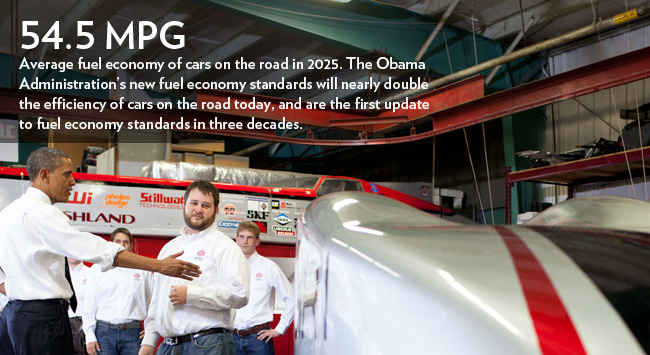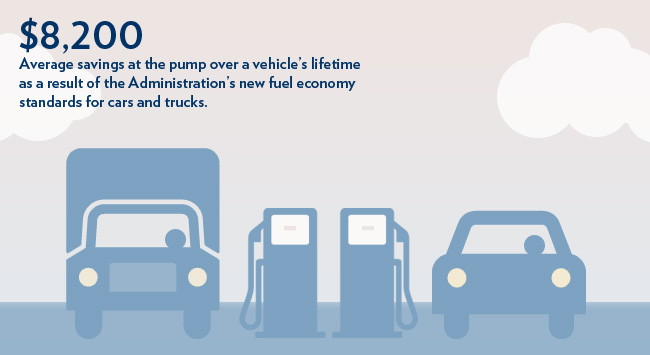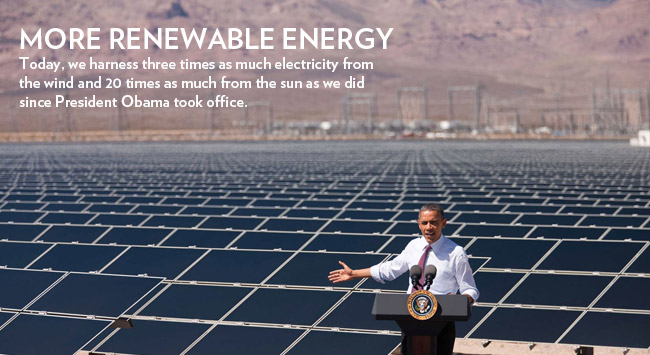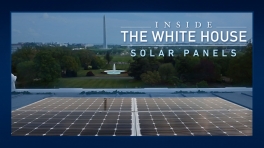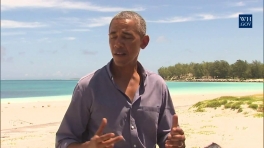Energy and Environment Latest News
Making Federal Investments Climate-Smart
Posted by on July 1, 2015 at 1:00 PM EDTClimate action makes fiscal and economic sense, and that is why we are taking new steps to code it into the DNA of how we do business at OMB.
Each year, OMB issues a revised Circular A-11. This is the Federal Government’s budgeting playbook. For the entire Executive Branch, the Circular provides the latest guidance and technical instruction on how to prepare, submit, and execute the Budget. Agencies are asked to submit budget requests that reflect the priorities of the Administration, including improving the efficiency and effectiveness of government and returning the highest value to the American taxpayer.
To that end, for the first time, the Circular includes an explicit requirement for the entire Executive Branch to ensure that funding requests in support of Federal facilities align with the Administration’s climate preparedness and resilience goals.
Specifically, OMB is asking all Federal agencies to consider climate preparedness and resiliency objectives as part of their Fiscal Year 2017 budget requests for construction and maintenance of Federal facilities. We are making it very clear that this is a priority in proposals for capital funding. Why? Because making our Federal facility investments climate-smart reduces our fiscal exposure to the impacts of climate change. It’s the right thing to do to run an efficient and effective government. And it’s the right thing to do to return the highest value to the American taxpayer.
Of course, climate-smart will take on different meaning for each agency and asset. Our Federal portfolio of real estate is incredibly diverse, from office buildings to hospitals to laboratories to warehouses and beyond. For example, the Department of Defense alone manages over 560,000 facilities globally. The climate impacts the breadth of our Federal real estate portfolio. Specifically, many of these assets, and the critical domestic and national security missions they support, are vulnerable to climate-related extreme weather events – like hurricanes, wildfire, floods, and drought. For instance, just last week, the National Park Service identified more than $40 billion in national park infrastructure and historic and cultural resources put at risk by sea level rise.
So, while the United States leads global efforts to reduce greenhouse gas emissions, we are also taking action to better prepare and become more resilient to the impacts of climate change today. That is why the Administration is working to reduce taxpayers’ exposure to the impacts of climate change through grants, technical assistance, and programs in sectors from transportation and water management to conservation and disaster relief. The reason is simple: we can reduce future costs by making smarter investments up front. It’s true for communities across the nation, and it’s true for the Federal Government.
Ali Zaidi is the Associate Director for Natural Resources, Energy and Science at the Office of Management and Budget.
Learn more about , Energy and EnvironmentProtecting Public Health and the Environment
Posted by on June 24, 2015 at 12:34 PM EDTPresident Obama is committed to protecting public health and the environment. Just yesterday, the White House hosted a Summit on Climate Change and Public Health. The Summit brought together senior White House and Administration officials, doctors, nurses, students, mothers, public health organizations, and deans from medical, public health and nursing schools around the country to, in the words of President Obama, “address the gathering challenges and costs that the threat of a changing climate poses to our nation’s health.”
Congress is moving in the other direction. This week, the House will begin debate on H.R. 2822, a bill that would undermine the Administration’s efforts to protect the health of communities around the country, including those that are the most vulnerable like children and the elderly. It would block common-sense carbon pollution standards for power plants, which if finalized as proposed would prevent more than 150,000 asthma attacks in kids and up to 6,660 premature deaths each year.
The bill would also prevent EPA from updating one of our most important air quality standards – the National Ambient Air Quality Standards for ozone. Updating national standards for ozone pollution, which is particularly harmful for children and adults with asthma, would, if finalized as proposed, prevent thousands of premature deaths and hospital admissions and prevent up to a million lost school days each year. These are just two of many provisions in the bill that would force EPA to ignore science at the expense of public health.
We have benefited from 40 years of success under the Clean Air Act. In fact, since the Clean Air Act was enacted with bipartisan support in 1970, the economy has more than tripled in size, while harmful air pollution has decreased by nearly 70 percent. The Administration will continue to defend the Clean Air Act and protect public health.
Ali Zaidi is the Associate Director for Natural Resources, Energy and Science at the Office of Management and Budget. Dan Utech is the Deputy Assistant to the President for Energy and Climate Change. Christy Goldfuss is the Managing Director of the Council on Environmental Quality.
Learn more about Energy and EnvironmentYour Health and Our Environment: How Can We Protect Both?
Posted by on June 18, 2015 at 6:51 PM EDTNational Dialogue on Climate Change And Health
There are a whole host of public health impacts that are going to hit home. The great thing about this conversation is to see all the work that’s already being done by public health officials, the medical community, nurses and families.
- President Obama
Today, the White House is convening a Summit to bring together health and medical professionals, academics, and other stakeholders to empower people and communities with the information and tools they need to protect public health in the face of climate change.
Learn more about Energy and EnvironmentWest Wing Week: 06/19/15 or, “Her Map & Compass”
Posted by on June 18, 2015 at 4:06 PM EDTThis week was Maker Week and Pollinator Week! The President was a busy bee himself. He stopped by a Congressional baseball game and a Congressional picnic, congratulated My Brother's Keeper mentees, and presided over the ceremonial swearing-in of Loretta Lynch as Attorney General. Meanwhile, the First Lady crossed the Atlantic in the name of Let Girls Learn and Let's Move! That's June 12th to June 18th or, "Her Map & Compass."
Deal Gives Back
Posted by on June 18, 2015 at 3:15 PM EDTEd. note: This is cross-posted on the U.S. Department of Agriculture's blog. See the original post here.
Here at USDA, we believe in the power of community to make a difference. So when Alice Deal Middle School in Washington, DC, reached out to the USDA Center for Faith-based and Neighborhood Partnerships to come visit for their annual day of service, we were eager to welcome over 100 seventh graders to our headquarters to talk about the importance of environmental awareness and conservation practices, their theme for this year. With seventy percent of the nation’s land under private ownership, the success of USDA’s partnership with landowners to clean the air we breathe, conserve and clean the water we drink, prevent soil erosion, and create and protect wildlife habitat will depend on developing a strong next generation of conservation leaders like the Alice Deal students. So too, will our ability to manage the public lands and waters, including our national forests and grasslands that we hold in trust for the American people.
After a day with these bright young students, we’ve learned that we’re in pretty good hands.
Learn more about Energy and EnvironmentUnleashing Climate Data and Tools to Empower America’s Transportation Sector
Posted by on June 17, 2015 at 12:21 PM EDTToday, in a major step to advance the President’s Climate Data Initiative and the Climate Resilience Toolkit, the Obama Administration is providing data and tools that will help ensure our nation’s transportation systems are more resilient to the effects of climate change.
In the United States, transportation systems are designed to withstand local weather and climate. Transportation engineers typically refer to historical records of climate, especially extreme weather events, when designing transportation systems. For example, bridges are often designed to withstand storms that have a probability of occurring only once or twice every 100 years.
However, due to climate change, historical climate is no longer a reliable predictor of future impacts.
The impacts of climate change – including more intense storms and storm surge damage, more severe droughts and heat waves, and sea-level rise – can increase the risk of delays, disruptions, damage, and failure across our land-based, air, and marine transportation systems. This is particularly important considering the interconnectivity of these systems. Actionable science, data, information, and tools can empower planners and decision makers to account for these impacts in the transportation sector, potentially helping avoid disruptions to operations and costly repairs, and helping ensure that major investments into infrastructure intended to last many decades is not put at risk prematurely.
Learn more about Energy and Environment
- &lsaquo previous
- 1
- 2
- 3
- 4
- 5
- 6
- 7
- 8
- 9
- …
- next &rsaquo
White House Blogs
- The White House Blog
- Middle Class Task Force
- Council of Economic Advisers
- Council on Environmental Quality
- Council on Women and Girls
- Office of Intergovernmental Affairs
- Office of Management and Budget
- Office of Public Engagement
- Office of Science & Tech Policy
- Office of Urban Affairs
- Open Government
- Faith and Neighborhood Partnerships
- Social Innovation and Civic Participation
- US Trade Representative
- Office National Drug Control Policy

